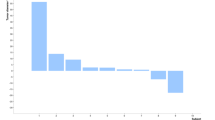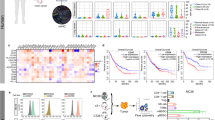Abstract
Immunotoxin therapy is a promising molecular cancer treatment strategy. Its main advantage is seletive cytotoxicity towards tumor cells and minimal toxicity in normal tissues. However, a short half-life and rapid clearance severely hampers its clinical application. We report here a novel genetic approach in which a recombinant adenovirus vector was used to deliver an immunotoxin gene e23(scFv)-PE40 targeted to the oncogene c-erbB-2 (also known as Her2/neu). This vector, when combined with a low dose of a conditionally replicative adenovirus vector (CRAd), has enhanced tumor-killing ability either alone or in combination with the chemotherapeutic agent etoposide. Our data show that low-dose CRAd facilitated the replication of replication-deficient Ad-e23(scFv)-PE40 up to 6–20 times and the transcription of e23(scFv)-PE40 gene up to 12 times. Moreover, etoposide increased the e23(scFv)-PE40 transcription up to 8.5 times. Furthermore, we show that systemic application of Ad-e23(scFv)-PE40 and enhanced expression of the immunotoxin gene was well tolerated as determined by serum biochemical markers and histological examination of most vital organs. Taken together, our data support a novel genetic immunotoxin delivery approach that may yield enhanced efficacy against a variety of Her2/neu-expressing tumors.
This is a preview of subscription content, access via your institution
Access options
Subscribe to this journal
Receive 12 print issues and online access
$259.00 per year
only $21.58 per issue
Buy this article
- Purchase on Springer Link
- Instant access to full article PDF
Prices may be subject to local taxes which are calculated during checkout






Similar content being viewed by others
Abbreviations
- Ad:
-
adenovirus
- CRAd:
-
conditionally replicative competent adenovirus
- FBS:
-
fetal bovine serum
- MOI:
-
multiplicity of infection
- PE:
-
Pseudomonas exotoxin
- scFv:
-
single-chain fragment variable
- TUNEL:
-
terminal deoxynucleotidyltransferase-mediated dUTP nick end labeling.
References
Burstein HJ . The distinctive nature of HER2-positive breast cancers. N Engl J Med 2005; 353: 1652–1654.
Pritchard KI, Shepherd LE, O’Malley FP, Andrulis IL, Tu D, Bramwell VH et al. HER2 and responsiveness of breast cancer to adjuvant chemotherapy. N Engl J Med 2006; 354: 2103–2111.
Ross JS, Fletcher JA, Linette GP, Stec J, Clark E, Ayers M et al. The Her-2/neu gene and protein in breast cancer 2003: biomarker and target of therapy. Oncologist 2003; 8: 307–325.
Stephens P, Hunter C, Bignell G, Edkins S, Davies H, Teague J et al. Lung cancer: intragenic ERBB2 kinase mutations in tumours. Nature 2004; 431: 525–526.
Swanton C, Futreal A, Eisen T . Her2-targeted therapies in non-small cell lung cancer. Clin Cancer Res 2006; 12: 4377s–4383s.
Slamon DJ, Godolphin W, Jones LA, Holt JA, Wong SG, Keith DE et al. Studies of the HER-2/neu proto-oncogene in human breast and ovarian cancer. Science 1989; 244: 707–712.
Lui VW, He Y, Goyal K, Huang L . Specific down-regulation of HER-2/neu mediated by a chimeric U6 hammerhead ribozyme results in growth inhibition of human ovarian carcinoma. Mol Ther 2001; 3: 169–177.
Kim MA, Jung EJ, Lee HS, Lee HE, Jeon YK, Yang HK et al. Evaluation of HER-2 gene status in gastric carcinoma using immunohistochemistry, fluorescence in situ hybridization, and real-time quantitative polymerase chain reaction. Hum Pathol 2007; 38: 1386–1393.
Shiau AL, Lin YP, Shieh GS, Su CH, Wu WL, Tsai YS et al. Development of a conditionally replicating Pseudorabies virus for HER-2/neu-overexpressing bladder cancer therapy. Mol Ther 2007; 15: 131–138.
Schlieman MG, Fahy BN, Ramsamooj R, Beckett L, Bold RJ . Incidence, mechanism and prognostic value of activated AKT in pancreas cancer. Br J Cancer 2003; 89: 2110–2115.
Eccles SA . The role of c-erbB-2/HER2/neu in breast cancer progression and metastasis. J Mammary Gland Biol Neoplasia 2001; 6: 393–406.
Schade B, Lam SHL, Cernea D, Sanguin-Gendreau V, Cardiff RD, Jung BL et al. Distinct ErbB-2-coupled signaling pathways promote mammary tumors with unique pathologic and transcriptional profiles. Cancer Res 2007; 67: 7579–7588.
Press MF, Cordon-Cardo C, Slamon DJ . Expression of the HER-2/neu proto-oncogene in normal human adult and fetal tissues. Oncogene 1990; 5: 953–962.
Slamon DJ, Leyland-Jones B, Shak S, Fuchs H, Paton V, Bajamonde A et al. Use of chemotherapy plus a monoclonal antibody against HER2 for metastatic breast cancer that overexpresses HER2. N Engl J Med 2001; 344: 783–792.
Piccart-Gebhart MJ, Procter M, Leyland-Jones B, Goldhirsch A, Untch M, Smith I et al. Trastuzumab after adjuvant chemotherapy in HER2-positive breast cancer. N Engl J Med 2005; 353: 1659–1672.
Joensuu H, Kellokumpu-Lehtinen PL, Bono P, Alanko T, Kataja V, Asola R et al. Adjuvant docetaxel or vinorelbine with or without Trastuzumab for breast cancer. N Engl J Med 2006; 354: 809–820.
Kreitman RJ, Pastan I . Immunotoxins for targeted cancer therapy. Adv Drug Deliv Rev 1998; 31: 53–88.
Pastan I, Hassan R, FitzGerald DJ, Kreitman RJ . Immunotoxin therapy of cancer. Nat Rev Cancer 2006; 6: 559–565.
Posey JA, Khazaeli MB, Bookman MA, Nowrouzi A, Grizzle WE, Thornton J et al. A phase I trial of the single-chain immunotoxin SGN-10 (BR96 sFv-PE40) in patients with advanced solid tumors. Clin Cancer Res 2002; 8: 3092–3099.
Jin FS, Youle RJ, Johnson VG, Shiloach J, Fass R, Longo DL et al. Suppression of the immune response to immunotoxins with anti-CD4 monoclonal antibodies. J Immunol 1991; 146: 1806–1811.
Fox E, Hwang JJ, Rizvi N, Sing A, Soho C, Marshall JL et al. Phase I study of the combination of the immunotoxin SGN-10 (BR96sFv-PE40) with docetaxel (DOC) in patients (pts) with solid tumors expressing Lewis-Y. Proc Am Soc Clin Oncol 2003; 222 (abstr 891).
Hassan R, Williams-Gould J, Watson T, Pai-Scherf L, Pastan I . Pretreatment with rituximab does not inhibit the human immune response against the immunogenic protein LMB-1. Clin Cancer Res 2004; 10: 16–18.
Yang AG, Chen SY . A new class of antigen-specific killer cells. Nat Biotechnol 1997; 15: 46–51.
Chen SY, Yang AG, Chen JD, Kute T, King CR, Collier J et al. Potent antitumour activity of a new class of tumour-specific killer cells. Nature 1997; 385: 78–80.
Huang Q, Zhang XW, Wang H, Yan B, Dewhirst M, Li CY . A novel conditionally replicative adenovirus vector targeting telomerase-positive tumor cells. Clin Cancer Res 2004; 10: 1439–1445.
Livak KJ, Schmittgen TD . Analysis of relative gene expression data using real-time quantitative PCR and the 2−CT method. Methods 2001; 25: 402–408.
Fleige S, Walf V, Huch S, Prgomet C, Sehm J, Pfaffl MW . Comparison of relative mRNA quantification models and the impact of RNA integrity in quantitative real-time RT-PCR. Biotechnol Lett 2006; 28: 1601–1613.
Siegall CB, Chaudhary VK, FitzGerald DJ, Pastan I . Functional analysis of domains II, Ib, and III of Pseudomonas exotoxin. J Biol Chem 1989; 264: 14256–14261.
Jinno Y, Ogata M, Chaudhary VK, Willingham MC, Adhya S, Fitagerald D et al. Domain II mutants of Pseudomonas exotoxin deficient in translocation. J Biol Chem 1989; 264: 15953–15959.
Hwang J, Fitzgerald DJ, Adhya S, Pastan I . Functional domains of Pseudomonas exotoxin identified by deletion analysis of the gene expressed in E. coli. Cell 1987; 48: 129–136.
Houchins JP . Immunotoxin-induced apoptosis. Stem cell 2000; 18: 384–385.
Jørgensen R, Merrill AR, Yates SP, Marquez VE, Schwan AL, Boesen T et al. Exotoxin A-eEF2 complex structure indicates ADP ribosylation by ribosome mimicry. Nature 2005; 436: 979–984.
Gallant CV, Raivio TL, Olson JC, Woods DE, Storey DG . Pseudomonas aeruginosa cystic fibrosis clinical isolates produce exotoxin A with altered ADP-ribosyltransferase activity and cytotoxicity. Microbiology 2000; 146: 1891–1899.
Palmer DH, Mautner V, Mirza D, Oliff S, Gerritsen W, van der Sijp JR et al. Virus-directed enzyme prodrug therapy: intratumoral administration of a replication-deficient adenovirus encoding nitroreductase to patients with resectable liver cancer. J Clin Oncol 2004; 22: 1546–1552.
Von Der Thüsen H, Kuiper J, Fekkes ML, De Vos P, Van Berkel TJ, Biessen EA . Attenuation of atherogenesis by systemic and local adenovirus-mediated gene transfer of interleukin-10 in LDLr−/− mice. FASEB J 2001; 15: 2730–2732.
Wang Y, Yang Z, Liu S, Kon T, Krol A, Li CY et al. Characterisation of systemic dissemination of nonreplicating adenoviral vectors from tumours in local gene delivery. Br J Cancer 2005; 92: 1414–1420.
Ambriovic-Ristov A, Gabrilovac J, Cimbora-Zovko T, Osmak M . Increased adenoviral transduction efficacy in human laryngeal carcinoma cells resistant to cisplatin is associated with increased expression of integrin αvβ3 and coxsackie adenovirus receptor. Int J Cancer 2004; 110: 660–667.
Hemminki A, Kanerva A, Liu B, Wang M, Alvarez RD, Siegal GP et al. Modulation of coxsackie-adenovirus receptor expression for increased adenoviral transgene expression. Cancer Res 2003; 63: 847–853.
Shieh GS, Shiau AL, Yo YT, Lin PR, Chang CC, Tzai TS et al. Low-dose etoposide enhances telomerase-dependent adenovirus-mediated cytosine deaminase gene therapy through augmentation of adenoviral infection and transgene expression in a syngeneic bladder tumor model. Cancer Res 2006; 66: 9957–9966.
Acknowledgements
We thank Dr Siyi Chen for the provision of e23(scFv)-PE40-bearing plasmids and Dr Aǹgang Yang for the provision of SK-BR-3 and SGC-7901cell lines. We are grateful for the technical assistant by Fang Wei, Xiafang Chen, Miaoying Yi, Yuhua Tian, Ping Xu, Kuangchen Xie and Yuanshan Lu in First People's Hospital, Shanghai Jiaotong University, for the statistic analyses by Yongbing Xiang and Yuting Tan in the Cancer Institute of Shanghai Jiaotong University. This work was supported by Grant of National Basic Research Project of China (2004CB518804), National Natural Science Foundation for Outstanding Youth (30325043, 30428015).
Author information
Authors and Affiliations
Corresponding authors
Additional information
Supplementary Information accompanies the paper on Cancer Gene Therapy website (http://www.nature.com/cgt)
Rights and permissions
About this article
Cite this article
Liu, X., Wu, J., Zhang, S. et al. Novel strategies to augment genetically delivered immunotoxin molecular therapy for cancer therapy. Cancer Gene Ther 16, 861–872 (2009). https://doi.org/10.1038/cgt.2009.30
Received:
Revised:
Accepted:
Published:
Issue Date:
DOI: https://doi.org/10.1038/cgt.2009.30



